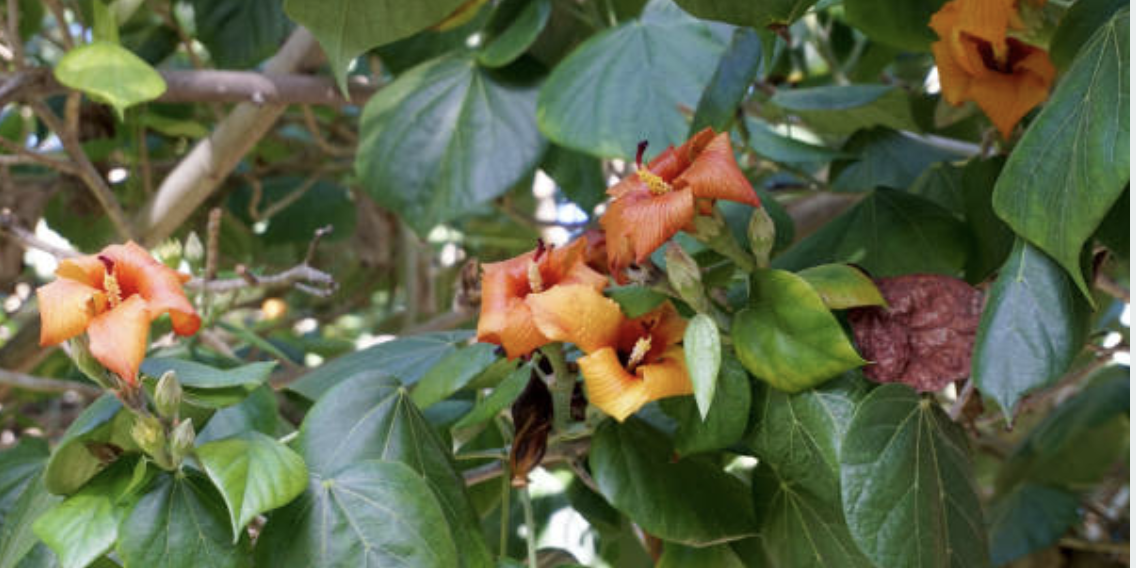Jamaica’s beauty goes far beyond its beaches and reggae rhythms. Tucked into the island’s hillsides and forests is a tree that’s as Jamaican as jerk chicken and patois: the Blue Mahoe (Hibiscus elatus). Declared the national tree in 1962—the same year Jamaica gained independence—the Blue Mahoe is more than just a plant. It’s a symbol of resilience, beauty, and national pride.
What Makes the Blue Mahoe Unique?
At first glance, the Blue Mahoe might not seem extraordinary. It’s a medium-to-large hardwood tree, often growing 40 to 60 feet tall. But the magic lies beneath its bark. When the wood is cut, it reveals a striking swirl of colors—green, blue, purple, and even grayish tones. No two pieces look the same. The grain is dense and fine, with natural patterns that give it a marbled or watercolor-like appearance.
This makes the Blue Mahoe one of the most sought-after woods for fine furniture, carvings, and turnery. It’s strong, easy to work with, and ages beautifully. Jamaican artisans have used it for generations to craft everything from bowls to sculpture to elegant cabinetry.
Roots in the Land
The Blue Mahoe is native to the Caribbean and Central America but thrives particularly well in Jamaica. It loves warm climates and moist, well-drained soil—conditions found in abundance in Jamaica’s tropical forests and mountain slopes.
Its fast growth rate and resilience make it ideal for reforestation projects. After heavy logging in the early 20th century, the Jamaican government encouraged the planting of Blue Mahoe to restore forest cover and stabilize soil. Today, it’s not just a national symbol—it’s a working tree that helps protect the environment.
A Symbol of Jamaican Identity
Choosing the Blue Mahoe as the national tree wasn’t just a botanical decision—it was a statement. As Jamaica stepped into independence, the country needed symbols that reflected its culture, strength, and future. The Blue Mahoe fit the bill perfectly.
Its wood mirrors the diversity of the Jamaican people—no two grains look the same, yet all are vibrant and strong. The tree itself is fast-growing and enduring, thriving in tough conditions, just like the island’s history and people. It represents beauty and utility, pride and practicality.
Where to See It
You don’t have to go deep into the bush to find a Blue Mahoe. The tree is planted in parks, gardens, and roadsides across the island. A good place to see mature specimens up close is Hope Gardens in Kingston, or Cinchona Botanical Gardens in the Blue Mountains and the Taste of Jamaica Farm and Garden in Ocho Rios.
If you’re heading out on a hike in the hills around Portland or St. Andrew, keep an eye out—especially in moist, upland forests. Even if you don’t spot one in the wild, you’ll likely encounter its wood in local craft markets or artisan shops.
Blue Mahoe in Jamaican Craft
One of the best ways to appreciate the Blue Mahoe is through the hands of Jamaican woodworkers. At shops in Kingston, Ocho Rios, and Montego Bay, you’ll find bowls, pens, and jewelry boxes made from this wood. Each piece is unique because of the natural grain and color variations.
Some workshops offer tours or live demonstrations where you can watch the wood being shaped, polished, and turned into something functional and beautiful. It’s a great way to connect with Jamaican culture through its natural heritage.
Not Just a Pretty Tree
The Blue Mahoe is also practical. Besides furniture and craft, it has been used for making yokes, tool handles, and even boat parts. Its fiber can be used to make rope. The tree also plays a role in ecological restoration and soil conservation.
And while not its main claim to fame, the Blue Mahoe does bloom. It produces hibiscus-like flowers—bright yellow at first, then turning orange and red as they age. These blooms add to the tree’s charm, especially during flowering season.
Final Thoughts
The Blue Mahoe is more than Jamaica’s national tree—it’s a living emblem of the island’s spirit. It reflects the strength, beauty, and creativity of the Jamaican people. Whether you’re admiring one in a garden, hiking past it on a trail, or running your fingers along a polished piece of Mahoe wood in a craft shop, you’re connecting with a deep part of Jamaican identity.
Next time you’re in Jamaica, take a moment to appreciate this unsung hero of the landscape. The beaches will always be there—but the Blue Mahoe tells a different story, one rooted in the heart of the island.









